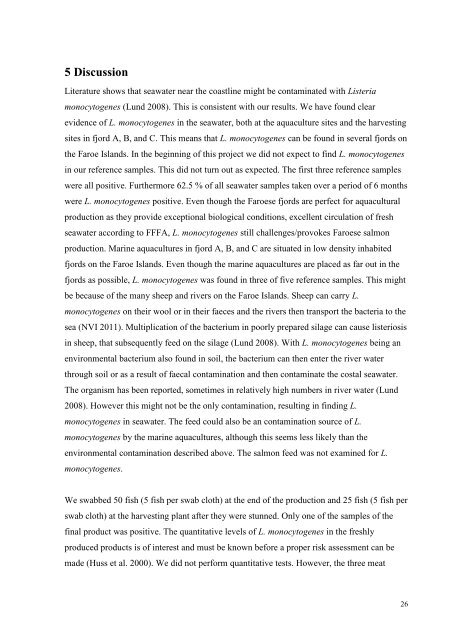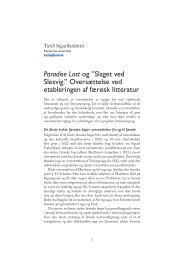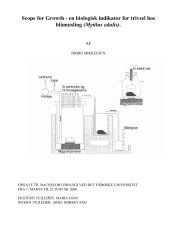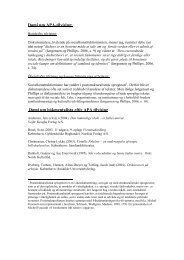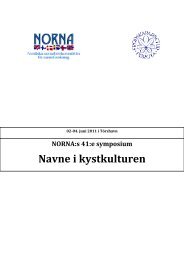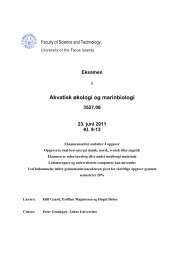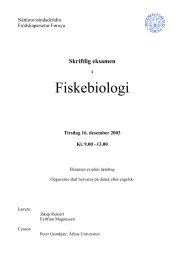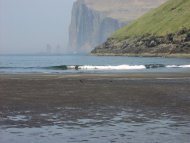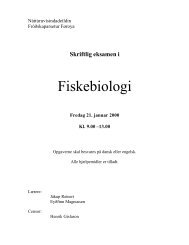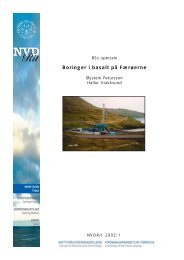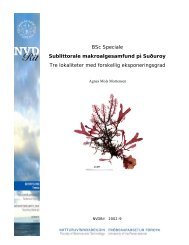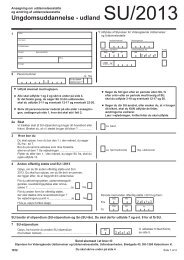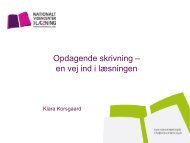Infectious Pancreatic Necrosis Virus (IPNV) - Fróðskaparsetur Føroya
Infectious Pancreatic Necrosis Virus (IPNV) - Fróðskaparsetur Føroya
Infectious Pancreatic Necrosis Virus (IPNV) - Fróðskaparsetur Føroya
Create successful ePaper yourself
Turn your PDF publications into a flip-book with our unique Google optimized e-Paper software.
5 Discussion<br />
Literature shows that seawater near the coastline might be contaminated with Listeria<br />
monocytogenes (Lund 2008). This is consistent with our results. We have found clear<br />
evidence of L. monocytogenes in the seawater, both at the aquaculture sites and the harvesting<br />
sites in fjord A, B, and C. This means that L. monocytogenes can be found in several fjords on<br />
the Faroe Islands. In the beginning of this project we did not expect to find L. monocytogenes<br />
in our reference samples. This did not turn out as expected. The first three reference samples<br />
were all positive. Furthermore 62.5 % of all seawater samples taken over a period of 6 months<br />
were L. monocytogenes positive. Even though the Faroese fjords are perfect for aquacultural<br />
production as they provide exceptional biological conditions, excellent circulation of fresh<br />
seawater according to FFFA, L. monocytogenes still challenges/provokes Faroese salmon<br />
production. Marine aquacultures in fjord A, B, and C are situated in low density inhabited<br />
fjords on the Faroe Islands. Even though the marine aquacultures are placed as far out in the<br />
fjords as possible, L. monocytogenes was found in three of five reference samples. This might<br />
be because of the many sheep and rivers on the Faroe Islands. Sheep can carry L.<br />
monocytogenes on their wool or in their faeces and the rivers then transport the bacteria to the<br />
sea (NVI 2011). Multiplication of the bacterium in poorly prepared silage can cause listeriosis<br />
in sheep, that subsequently feed on the silage (Lund 2008). With L. monocytogenes being an<br />
environmental bacterium also found in soil, the bacterium can then enter the river water<br />
through soil or as a result of faecal contamination and then contaminate the costal seawater.<br />
The organism has been reported, sometimes in relatively high numbers in river water (Lund<br />
2008). However this might not be the only contamination, resulting in finding L.<br />
monocytogenes in seawater. The feed could also be an contamination source of L.<br />
monocytogenes by the marine aquacultures, although this seems less likely than the<br />
environmental contamination described above. The salmon feed was not examined for L.<br />
monocytogenes.<br />
We swabbed 50 fish (5 fish per swab cloth) at the end of the production and 25 fish (5 fish per<br />
swab cloth) at the harvesting plant after they were stunned. Only one of the samples of the<br />
final product was positive. The quantitative levels of L. monocytogenes in the freshly<br />
produced products is of interest and must be known before a proper risk assessment can be<br />
made (Huss et al. 2000). We did not perform quantitative tests. However, the three meat<br />
26


